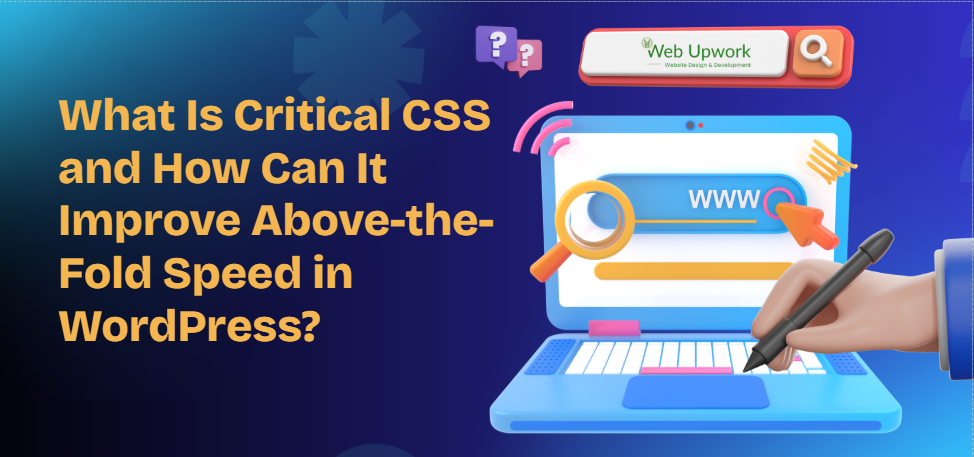When we talk about website speed, one common complaint I hear from clients is – “My site looks blank for a few seconds before loading.” Even if the final load time is decent, that empty white screen creates a bad first impression.
This is where Critical CSS comes into play. It is one of the most underrated but powerful techniques for improving what we call above-the-fold speed – basically, how quickly the part of the page visible without scrolling appears on screen.
In my opinion, Critical CSS is not just a fancy developer term, it is a real game-changer for WordPress sites.
What Is Critical CSS?
When a browser loads your website, it first downloads the HTML, then fetches all CSS files to style the content. If your theme or plugins load large CSS files, the browser blocks rendering until everything is downloaded and parsed.
Critical CSS means extracting only the styles needed to display the above-the-fold content, and inlining them directly into the page. This way, visitors see the top part of the site instantly, while the rest of the CSS can load in the background.
It’s like serving the starter dish quickly so the guest doesn’t stay hungry while waiting for the main course.
Why Critical CSS Matters
Google’s Core Web Vitals now make speed a ranking factor. One important metric is First Contentful Paint (FCP), which measures how fast something appears on screen. Critical CSS directly improves this.
From my experience:
-
A site with slow above-the-fold speed feels broken, even if the full load time is 2–3 seconds.
-
Indian users, who often rely on mobile data networks, drop off very quickly when they see a blank screen.
-
A faster first impression keeps users engaged and reduces bounce rates.
How Critical CSS Improves Above-the-Fold Speed in WordPress
Here are the key benefits I have seen while implementing it:
-
Faster First Paint
The top part of the site loads instantly, giving the impression of speed. -
Better Core Web Vitals
Direct improvement in FCP and Largest Contentful Paint (LCP). -
Improved User Experience
Even if the rest of the page is still loading, the visitor sees content right away. -
SEO Benefits
Google rewards sites that render fast, and Critical CSS contributes to this. -
Lower Bounce Rate
Visitors don’t abandon the site during those first 2–3 critical seconds.
How to Implement Critical CSS in WordPress
From a practical point of view, there are two ways:
1. Plugins and Automation
-
Autoptimize and WP Rocket have Critical CSS options.
-
These tools automatically generate above-the-fold CSS for each page.
2. Manual Approach
-
Developers can use tools like Critical (Node.js) or online generators.
-
Extract only the required CSS and inline it in the header.
Personally, I prefer plugin automation for client sites because it balances accuracy with ease of use.
Point of View
In India, we often design websites with heavy themes and multipurpose page builders. They look beautiful, but they also come with massive CSS files, sometimes 300–400 KB. This makes the first screen painfully slow to appear.
I strongly feel that Critical CSS is not just about technical optimisation. It is about psychology. If the user sees something load quickly – the header, logo, or menu – they feel the site is responsive and trustworthy.
Last year, I optimised a fashion eCommerce site that had a 4-second blank screen issue. By implementing Critical CSS, the above-the-fold section appeared in under 1 second. The bounce rate dropped by 18%, and customers started exploring more products.
This is why I always recommend Critical CSS as a priority step in WordPress speed optimisation. It delivers real value not just in numbers, but in user perception.
Product Schema
{% if template.name == 'product' %}
<script type="application/ld+json">
{
"@context": "https://schema.org/",
"@type": "Product",
"name": "{{ product.title }}",
{%- if product.featured_media -%}
{%- assign media_size = product.featured_media.preview_image.width | append: 'x' -%}
"image": [
{{ product.featured_media | img_url: media_size | prepend: "https:" | json }}
],
{%- endif -%}
"description": {{ product.description | strip_html | json }},
"sku": "{{ current_variant.sku }}",
"mpn": "{{ current_variant.barcode }}",
"brand": {
"@type": "Brand",
"name": "District A Design"
},
"review": {
"@type": "Review",
"reviewRating": {
"@type": "Rating",
"ratingValue": "5",
"bestRating": "5"
},
"author": {
"@type": "Person",
"name": "Example site"
}
},
"aggregateRating": {
"@type": "AggregateRating",
"ratingValue": "5",
"reviewCount": "5"
},
"offers": {
"@type": "Offer",
"url" : {{ shop.url | append: variant.url | json }},
"priceCurrency" : {{ cart.currency.iso_code | json }},
"price" : {{ current_variant.price | divided_by: 100.00 | json }},
"priceValidUntil": "{{ 'now' | date: '%s' | plus: 31536000 | date: '%Y-%m-%d' | uri_encode | replace:'+','%20' }}",
"itemCondition": "https://schema.org/NewCondition",
"availability" : "http://schema.org/{% if product.available %}InStock{% else %}OutOfStock{% endif %}"
}
}
</script>
{% endif %}
BreadcrumbList Schema
<script type="application/ld+json">
{
"@context": "https://schema.org",
"@type": "BreadcrumbList",
"itemListElement": [{
"@type": "ListItem",
"position": 1,
"name": "Home",
"item": "https://Examplesite.com/"
},{
"@type": "ListItem",
"position": 2,
"name": "{{ product.title }}",
"item": "{{ shop.url }}{{ product.url }}"
}]
}
</script>





